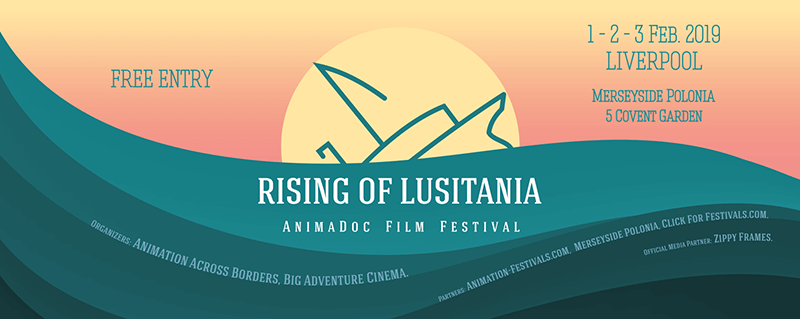Inaugural Award Winners of New Animated Documentary Festival: Rising of Lusitania
After four years fighting for Liverpool, as the only one place on the Earth for this kind of festival, and 100 years after Winsor McCay’s “The Sinking of the Lusitania”, the first edition of the Rising of Lusitania – AnimaDoc Film Festival sailed on its maiden voyage.
From classical to more experimental approaches, the three day festival, which took place at Liverpool’s Merseyside Polonia between 1-3 February, presented the huge variety of special screenings, lectures, and 35 amazing short animated documentaries from 22 countries.
Juliette Marchand, Kim Noce and Aaron Wood – The first Lusitania Jury have had a considerable challenge to choose the laureates. After long discussion finally they made it! Kim Noce said:
Among the selections there were so many good film and it was hard to choose the awards, a jury is a snapshot of 3 minds coming together for a brief moment in time. Quality is not the issue, all films had something remarkable at the time but like in a beautiful forest you might spot one bird rather than an another. One can’t help subjectivity and chance.
Grand Prix “Lusitania Award” for the Best AnimaDoc
The Driver Is Red (USA 2017), by Randall Christopher
Jury Statement: The Jury thought that this film did an excellent job of portraying a historic event in an engaging fashion, through its narrative and visual style. It’s framing of factual information and use of ‘true crime documentary’ technique, kept a level of high suspense throughout, right to the capture of one of the highest ranking Nazi war criminals on the run.
Special Lusitania Jury Award
Egg (France/Denmark 2018), by Martina Scarpelli
Jury Statement: In this case for the Jury Award this might be the perfect example of cinema and animation through visual metaphor. A film that pushes a little further the boundaries of what can and cannot be represented in a documentary. Egg seems to follow the narrative developed by James Joyce and Samuel Beckett through the inner voice both in term of content and visually using animation for something that otherwise could be hard to grasp in a short format and difficult to represent without being very direct: the fear of death and life in the denial of what nourishes us. And within that the sense of one own space and body awareness, the sensations of what it feels like to exist to taste life through visualise. A remarkable intelligent film that hopefully will nourish filmmaker to look beyond what is the representation of reality in animation documentary.
“Rising Award” for the Best Student Movie
The Children Of Concrete (France 2017), Jonathan Phanhsay-Chamson
Jury Statement: We appreciate the freedom used with animation. Choice of the technic who serve the idea very well in a simple, graceful, minimal and smart way. We would also congratulate the efficiency and sharpness of the voice, soundtrack, rythme between sound and image. Then, finally, the topic is great, changing a lot from what we keep earring about it. You bring something to the point. Well done!
“Make-Believe Award” for the Best AnimaMockumentary
Life of Death (Indonesia 2018), by Bryan Arfiandy and Jason Kiantoro
Jury statement: This film was a perfect example of a Mockumentary animated film; it’s parody of the reality TV documentary genre being a perfect vehicle for a humorous take on death. From a well crafted script peppered with both laugh-out-loud moments and an emotional finale; to the simple but highly effective visual design and animation, we felt this was a very worthy winner for the “Make Believe Award”.
Lusitania Audience Award
Life of Death (Indonesia 2018), by Bryan Arfiandy and Jason Kiantoro
Special Mentions
- Best Portrait – Carlotta’s Face (Germany 2018), by Valentin Riedl
- Current Event – The Children Of Concrete (France 2017), by Jonathan Phanhsay-Chamson
Jury statement: “Carlotta’s face” is a beautiful self contained film creating an unexpected charming aesthetic for a rare neurological diversity. The content is revealed slowly allowing the audience to journey across Carlotta realisation within the film and discover the story with her, rather than creating a prescriptive explanation. A touching small gem of narrative, style and tenderness.


